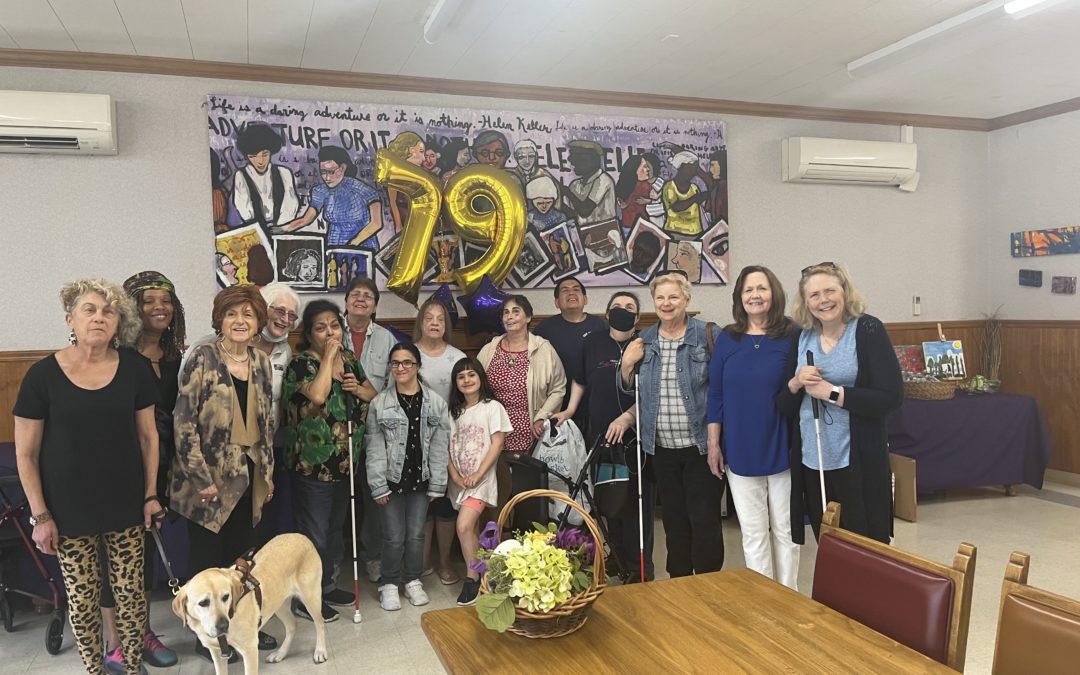
by Carly Eden Stokes | Jun 21, 2022 | Blog, Events, News
We’re ecstatic to say: WE DID IT!
OUR FIRST ANNUAL DAY OF GIVING WAS A HUGE SUCCESS!
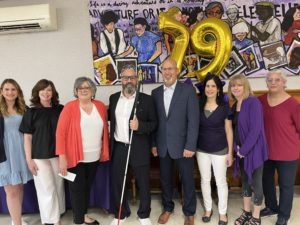
VLANJ staff members pose with Dave Steele, “The Blind Poet.”
For our first annual Day of Giving, our goal was to raise $7,900 celebrating 79 years of VLANJ, in 1 day, 9 hours, and 43 minutes – in honor of VLANJ’s founding year of 1943. Not only did we meet that goal, but with the help of our incredible donors and individuals and brands helping to spread the word, we exceeded it!
For our first ever Day of Giving, we raised $10,200, surpassing our goal of $7,900 by a landslide! We also received 72 gifts and participation from 69 donors, 21 of whom were new donors, and 21 donations made generously by VLANJ program participants.
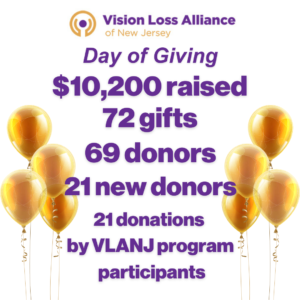
A graphic depicts VLANJ’s incredible results from their first annual Day of Giving.
We want to say a huge, resounding “thank you” to all those who helped us spread awareness, gave a donation, and/or came to visit us in person during our 1 day, 9 hour, and 43 minute event.
For this event, support came from all over the world – literally! A huge highlight on our Day of Giving was a special in-person event featuring Dave Steele, “The Blind Poet,” during which he came to speak at our Denville, NJ location (all the way from the UK!). Dave shared about his inspiring journey with vision loss, performed an amazing in-person poetry reading, and, afterwards, met with VLANJ community members. Many VLANJ program participants traveled to celebrate our Day of Giving with us in person, enjoying in-person programs, events, and of course some celebratory cake and balloons.
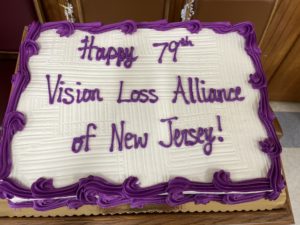
A white cake with purple frosting reads: “Happy 79th Vision Loss Alliance of New Jersey!”
Thank you to Dave Steele, CONQUERing, WagALot Pet Shop, local Denville, NJ businesses such as Inspiration Roll, The Pasta Shop Denville, Thatcher McGhee’s Denville, Bold Blind Beauty, and individuals including but not limited to Anne, Claire Sisk, Monica Pruitt, Sadi Taylor, and Katie’s Vision for donating unique gifts and/or helping us to spread the word!
We are so grateful for such a generous display of kindness and support! Because of it, we are able to continue offering services, aid, and resources to those living with vision loss who need it.
We look forward to all that next year has in store – stay tuned for our 80th year celebration!
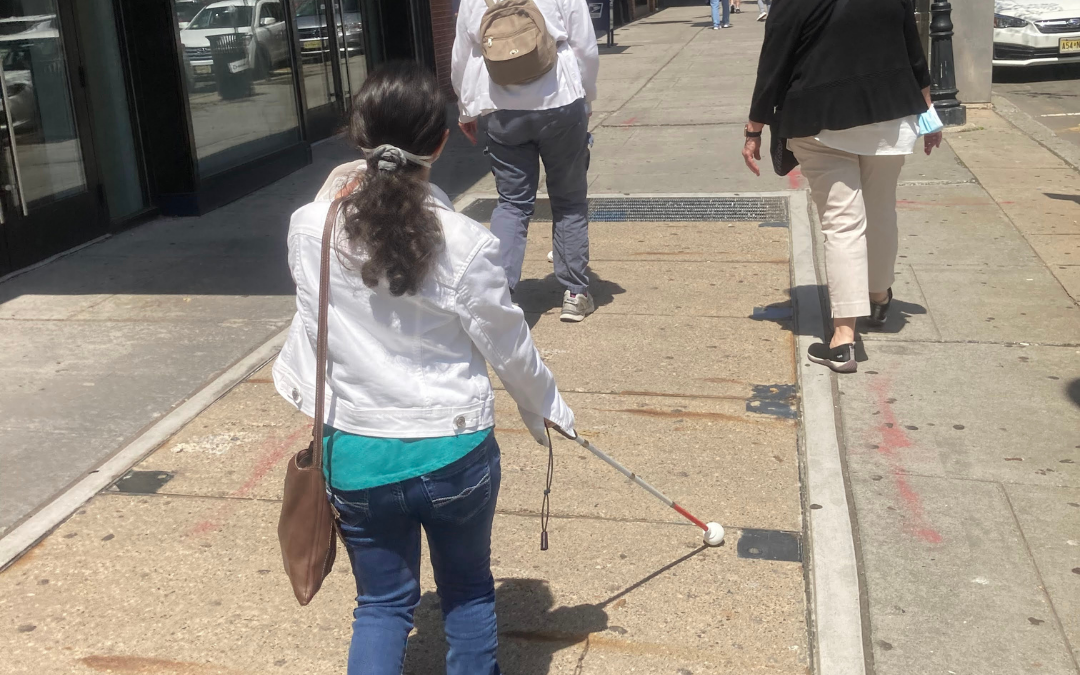
by Carly Eden Stokes | May 27, 2022 | Blog, News, Press Releases
MORRISTOWN, NJ (May 26, 2022) — Guide dogs are part of Morristown’s fabric, but on Monday, participants from Vision Loss Alliance of New Jersey used white canes to traverse the town’s sidewalks and intersections.
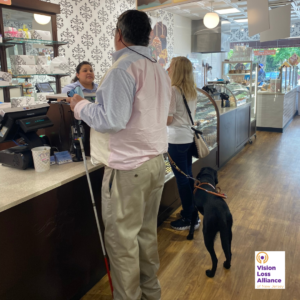
An individual holds a white cane while another has a guide dog at the checkout counter of a Morristown, NJ business.
Three orientation and mobility specialists from The Seeing Eye and VLANJ’s O&M expert provided one-on-one instruction to participants on a route that included several blocks of Maple Avenue and South Street. While one group of participants received instruction, the other toured a local business, and after lunch, they swapped roles.
“It’s so important for people with vision loss and blindness to learn mobility skills and practice how to safely navigate indoor and outdoor public spaces, as well as sidewalks, and crosswalks,” VLANJ Vice President of Programs Elsa Zavoda said. “It provides them greater self-confidence to venture out in their own communities and beyond.”
The O&M outing was the third in a series, generously funded by grants from the William G. and Helen C. Hoffman Foundation and the Lydia Collins deForest Charitable Trust. The O&M specialists from The Seeing Eye, including VLANJ trustee Lukas Franck, volunteered their services.
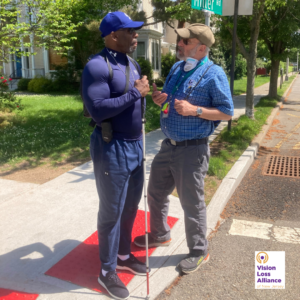
Two individuals stand at a street corner in Morristown. One holds a white cane.
Peggy Kane went out with The Seeing Eye’s Kristin Lake, who first fitted her with a global positioning system that alerted Kane to upcoming intersections. As they walked along Maple Avenue, Lake noted uneven sidewalks in places, and reviewed cane techniques. Kane knew the importance of listening to traffic flow to know when it’s safe to cross an intersection that doesn’t have a walking signal.
“I don’t travel out in the community by myself as much anymore, so it was good to have the opportunity to practice my outdoor navigation skills,” Kane said.
Franck, a senior consultant at The Seeing Eye, worked with Marvin Morgan. At the traffic light at Maple Avenue and Miller Road, Franck coached Morgan to raise his pole to signal his intention to cross before stepping into the crosswalk.
Inside Braunschweiger Jewelers on South Street, owner Gretchen Braunschweiger stood at a circular display case and took out highly textured estate pieces for the VLANJ participants to handle.
Feeling a thick gold chain, Matthew Graves said, “This feels like a glow stick.” He tapped on a thick, smooth sterling silver bangle and said,“it feels and sounds like glass!”
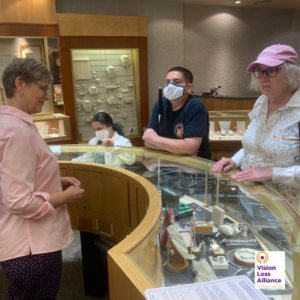
Two individuals stand at the counter of Braunschweiger Jewelers in Morristown. A woman greets them behind the counter.
After examining more than a dozen pieces of jewelry, the VLANJ participants showed Braunschweiger mobility techniques they learned. Mary Ann Zino demonstrated trailing, using her cupped hand to feel her way around the circular jewelry display. Nicole Klein showed her different cane techniques to move around the store.
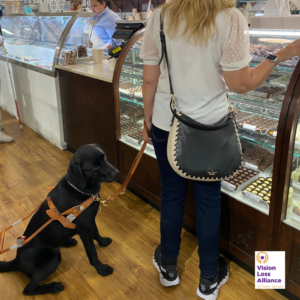
A woman holds her guide dog in front of a counter filled with sweets at a local Morristown business.
Braunschweiger said people with vision loss often visit the store, but usually, they are with guide dogs. When they enter, “someone goes up to the front to greet them,” she said.
After lunch, the participants who did orientation and mobility training in the morning visited Blue Mercury, a makeup and skin care shop on the Morristown Green. The VLANJ participants learned about products and smelled perfumes and colognes, and demonstrated human guide technique to Blue Mercury staff. The outing ended with a visit to Kilwins Morristown for ice cream.
About Vision Loss Alliance of New Jersey
Vision Loss Alliance of New Jersey is a 501(c)(3) that provides practical training and emotional support to help those who have experienced profound vision loss regain self-esteem and self-reliance. Since its founding in 1943, Vision Loss Alliance of New Jersey has used a holistic approach to empower those with profound vision loss to live engaged, productive and independent lives. Explore vlanj.org for more information.
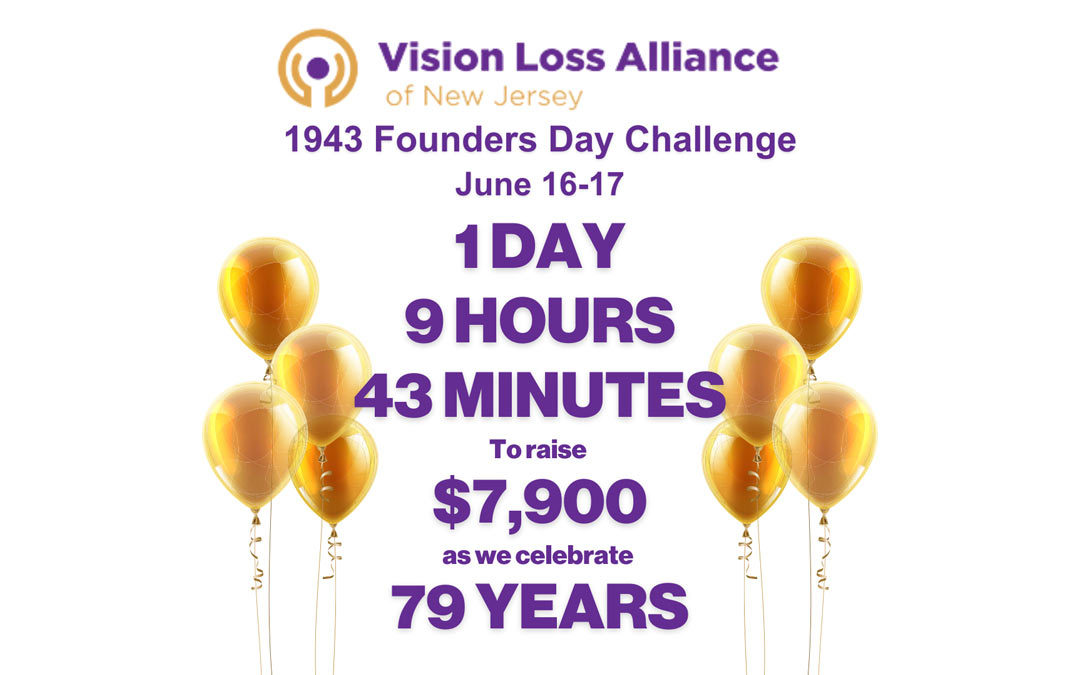
by Carly Eden Stokes | May 6, 2022 | Blog, Events, News
Save the Date! The 1st Annual VLANJ Day of Giving will begin on Thursday, June 16th and continue until Friday, June 17!
Our goal is to raise $7,900 in 1 day, 9 hours, and 43 minutes – in honor of our founding year of 1943.
The VLANJ Day of Giving brings our community of program participants, alumni, staff, and friends together in support of our mission and history of providing services to people with vision loss.
Our Goal: Our goal of raising $7,900 honors our home and our history where our program participants have spent time together learning skills to lead an independent life and where generations of alumni, families, friends, and staff have helped to shape VLANJ. On the Day of Giving, we celebrate our shared connection to this special place in Denville, NJ.
Our History: It all began in 1943, when a group of individuals met to address societal bias against people who, like themselves, were blind or had profound vision loss. They formed the New Jersey Association for the Blind and started the state’s first summer residential camp program for women in Denville, NJ. The founders focused on women’s needs because they had fewer options for leading an independent life at that time. Under the name NJ Foundation for the Blind, the summer camp expanded its offerings to provide life-skills training to help those with vision loss live more independent lives.
Over time, it became evident that providing tools to promote independence was key to helping individuals with vision loss. VLANJ recognized this growing need and expanded its mission to focusing on teaching basic and essential life skills, as well as providing health and wellness activities year-round for both men and women. Currently, VLANJ offers a full continuum of in person programs in Denville and select programs in Ridgewood. VLANJ also provides virtual classes to individuals and families all over the world!
Honor: Make your donation in honor of or in memory of a person with vision loss or a person who has provided services to help people with vision loss.
Make your donation to support our annual fund and help us continue to provide services for the next 79 years and beyond!
Can’t wait until June 16th? You can make your Day of Giving gift now and be counted or help us spread the word by sharing this link: https://www.vlanj.org/vlanjdayofgiving2022/
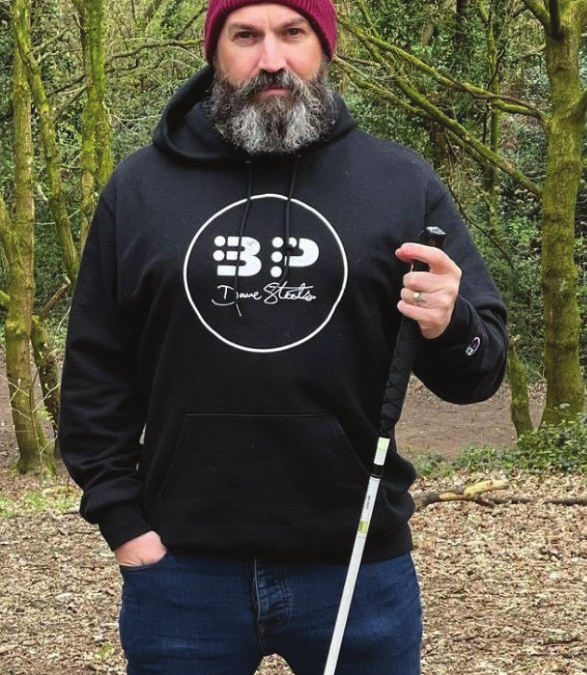
by Carly Eden Stokes | Apr 20, 2022 | Blog, News, Newsletters
A legally blind reverend offered advice on breaking the cycle of negative thinking. An English musician who lost his sight in his late 30s described how writing poems and lyrics helped him reclaim his purpose. A dietician specializing in diabetes gave tips to maintain well-being through healthy eating and exercise.
That’s a sampling of Vision Loss Alliance of New Jersey’s speaker series, Achieve Resilience, Inspiration & Self-Empowerment (ARISE). More than 150 people have registered for the series, which kicked off last September.
“It’s about inspiring people with vision loss to persevere and rise up,” said VLANJ Vice President of Programs Elsa Zavoda. “We want people to feel they have no barriers to what they want to achieve.”
ARISE runs four times a year. It is one of several speaker series made possible by a nearly $16,000 grant from Atlantic Health System/ Morristown Medical Center for programs that support healthy aging.
Living Independently For Tomorrow (LIFT) is the online version of VLANJ’s effective in-person Essential Low Vision course. It provides basic training in daily life activities over three weeks. Strength Through Relationships, Insights, Values, Education (STRIVE) addresses mental health aspects of adjusting to life with vision loss.
VLANJ Voices Education Speaker Series is the newest offering, and has attracted more than 100 people, Zavoda said. For the inaugural webinar, an orientation and mobility specialist discussed tips and strategies for getting around. In February, participants learned about a national pharmacy devoted to patients with vision loss.
In addition to broadening participants’ knowledge, ARISE and the other programs “establish human connection, so people don’t feel alone and isolated,” Zavoda said. The virtual programs are especially beneficial to participants who lack transportation to the in-person classes in Denville and Ridgewood.
ARISE has received overwhelmingly positive reviews from participants. Dora Meler said the program motivated her and made her feel less alone. It helped her “remember that there are others out there experiencing the same life challenges as I am,” she wrote. “It’s important to continue to find ways to lead an independent life versus not venturing out of the comfort of my home.”
Michele Valuzzi said she related to David Steele, The Blind Poet. “As someone who has written poetry but hadn’t in a long time, I was inspired by Dave’s talk, and I started writing poems again,” Valuzzi said. “His life is a great example of resiliency because he doesn’t let his visual impairment hold him back or define him.”
Explore more of what VLANJ’s programs offer here.
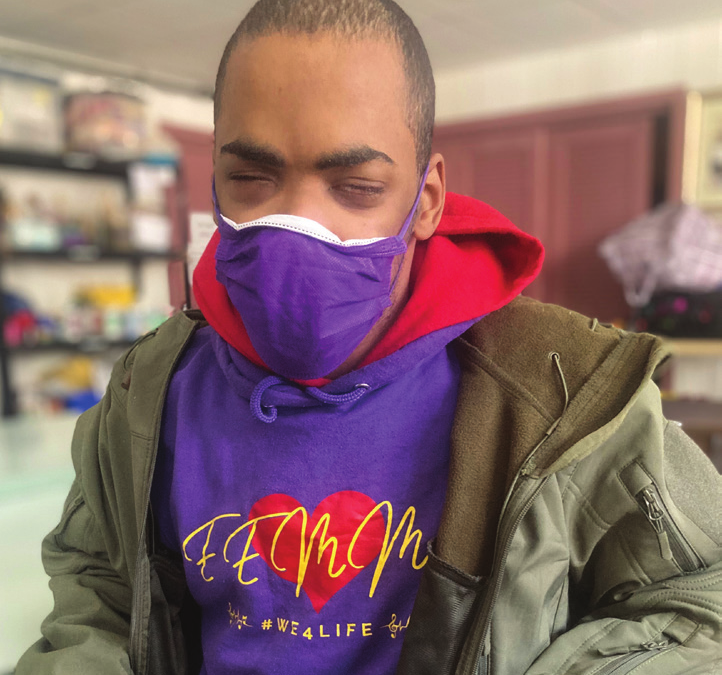
by Carly Eden Stokes | Apr 20, 2022 | Blog, News, Newsletters
Five years after attending Vision Loss Alliance of New Jersey’s technology program as a high schooler, 23-year-old Aaron Grimes now spends his Tuesdays teaching others without sight all the ways their iPhones can serve them.
“I like sharing my knowledge, and making someone’s life a little bit easier,” he said. Aaron was pre-school age when he became blind. He was born with both congenital glaucoma and aniridia, a genetic disorder that prevented his irises from fully developing, he said. Aaron doesn’t recall much about his sighted years, but has memory of colors. An infection that hospitalized him for weeks claimed all his sight except for a little light perception in his left eye. Aaron attended public primary schools in Jersey City, where he’s always lived. “When I was a kid, I didn’t feel included,” he said. While attending a high school for the blind in 2017, his rehabilitation counselor encouraged him to take classes at VLANJ.
“I learned how to use advanced apps on the iPhone,” he said. One of his favorites is Seeing AI [Artificial Intelligence], which reads documents, handwriting, and barcodes on products, and identifies denominations of money. With Be My Eyes, a sighted volunteer appears on video and provides assistance. Volunteers have helped Aaron adjust his thermostat and pick out clothing. For news, he turns to NFB-NEWSLINE from the National Federation for the Blind, which reads aloud articles from popular sources.
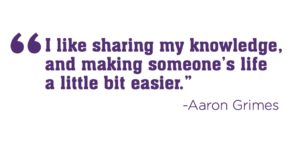
A quote in purple letters reads: “I like sharing my knowledge, and making someone’s life a little bit easier.” – Aaron Grimes
“I still use all of them,” he said. When VLANJ reopened in-person classes in September, Aaron began volunteering with the mobile technology program. He takes two Access Link buses to get to Denville, often spending two or more hours traveling each way.
On a recent Tuesday, Aaron was showing Susan, a student with glaucoma, how to use the VoiceOver app that reads what is on her screen. “Aaron is great! He really helps me,” she said.
Aaron is typically paired with an instructor in the morning, and then works one-on-one with a student in the afternoon. He is eager to teach advanced apps, but understands students need to know the basics first. Aaron also makes sure students’ iPhones have the latest updates. “They call me `Zippy’ because I’m fast,” he said with a laugh.
Aaron hopes more younger adults discover VLANJ, but for now, he enjoys helping the older participants. Volunteering with VLANJ has given him purpose. “I’m happy with what I’m doing,” said Aaron, who lives with an older brother and sister-in law. (His mother died 10 years ago.) “I like spending time here. It’s nice making friends.”
Donations to Vision Loss Alliance can be made online at vlanj.org/donations or by mailing a check to Vision Loss Alliance of New Jersey, 155 Morris Ave., Suite 2, Denville, NJ, 07834, ATTN: VP of Development and Communications Jennifer Singer
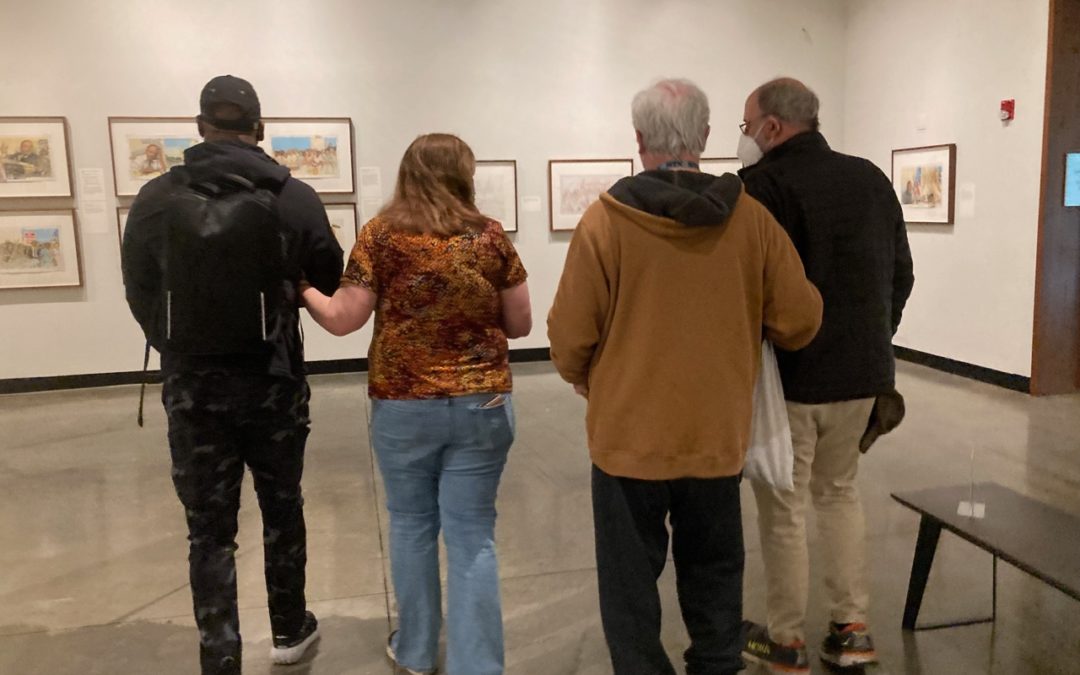
by Carly Eden Stokes | Mar 30, 2022 | Blog, Events, News, Press Releases
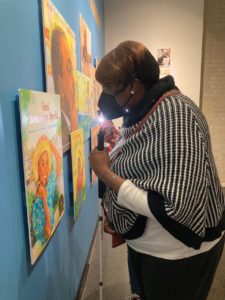
Valerie Frink of Jersey City, a VLANJ participant, closely inspects a bright, colorful work by artist Jerry Pinkney, using the flashlight on her mobile phone.
MONTCLAIR, NJ (March 30, 2022) — As part of its effort to expand access for people with special needs, the Montclair Art Museum last week gave Vision Loss Alliance of New Jersey participants a guided exhibit tour that featured detailed audio descriptions of artwork and multi-sensory objects to help visualize pieces.
“I liked being able to feel the object related to the artwork, and hear about the artist and materials used,” said VLANJ participant Debbie Tester, who has lost most of her sight to a degenerative eye disease. “It helped me get a picture in my head.”
The MAM tour was VLANJ’s second orientation and mobility community outing to learn and practice getting around in public spaces. The outings are generously funded by grants from the William G. and Helen C. Hoffman Foundation and the Lydia Collins deForest Charitable Trust. Two VLANJ orientation and mobility experts accompanied the group and provided training inside the museum and on its grounds.
VLANJ participants gave MAM’s program high marks. “Make it longer!” suggested Roman Dodia. Montclair State University Associate Professor Maria José Garcia Vizcaíno, who volunteers as a docent, narrated the exhibit, “Transformed: Objects Reimagined by American Artists.”
![VLANJ participants view a black panther sculpture during a Montclair Art Museum tour on March 25. [MAM photo credit]](https://www.vlanj.org/wp-content/uploads/2022/03/IMG_4727-225x300.jpeg)
VLANJ participants view a black panther sculpture during a Montclair Art Museum tour on March 25. [MAM photo credit]
MAM is committed to expanding access for people with special needs. It recently created the position of assistant director of Community and Access Programs, held by Celene Ryan. The museum offers virtual programs and runs in-person art classes that provide more support, with one-on-one or small-group instruction, Ryan said. New Jersey residents who receive Division of Developmental Disabilities funding can use the money to take MAM classes, she noted.
The VLANJ participants asked astute questions as they moved through the gallery, Ryan said. “They were really engaged.” They then provided feedback on the tour and MAM’s accessibility efforts in a focus group run by Montclair State University Associate Professor Elaine Gerber.
The nine VLANJ participants offered a range of useful suggestions, such as having the museum’s floor plan mapped on a GPS system like GoodMaps to help visually impaired people get around. They suggested information about artwork on plaques have a companion audio description, and that tape on the floor marking how close visitors can get to artwork be textured so people using canes can identify it.
VLANJ Vice President of Programs Elsa Zavoda demonstrated mobile phone apps that allow people with vision impairment to listen to written information about artwork. Because of the museum’s high ceilings, Zavoda recommended MAM tour guides use lapel amplifiers so visitors don’t miss narrations.
Museum Director Ira Wagner noted MAM tries to incorporate social elements into programming, inviting artists to speak. To thank VLANJ participants for their input on improving access, Wagner offered the group one-year memberships to MAM.
For more information about MAM, visit montclairartmusuem.org.
Visit vlanj.org to learn about VLANJ programs.
————-
About Vision Loss Alliance of New Jersey
Vision Loss Alliance of New Jersey is a 501(c)(3) that provides practical training and emotional support to help those who have experienced profound vision loss regain self-esteem and self-reliance. Since its founding in 1943, Vision Loss Alliance of New Jersey has used a holistic approach to empower those with profound vision loss to live engaged, productive and independent lives. Go to vlanj.org for more information.
About the Montclair Art Museum
The Montclair Art Museum (MAM) boasts a renowned collection of American and Native American art that uniquely highlights art-making in the United States over the last 300 years. The Vance Wall Art Education Center encompasses the Museum’s educational efforts, including award-winning Yard School of Art studio classes, lectures and talks, family events, tours, and the mobile MAM Art Truck. MAM exhibitions and programs serve a wide public of all ages and abilities, from families and seniors to artists, educators, and scholars.
















![VLANJ participants view a black panther sculpture during a Montclair Art Museum tour on March 25. [MAM photo credit]](https://www.vlanj.org/wp-content/uploads/2022/03/IMG_4727-225x300.jpeg)